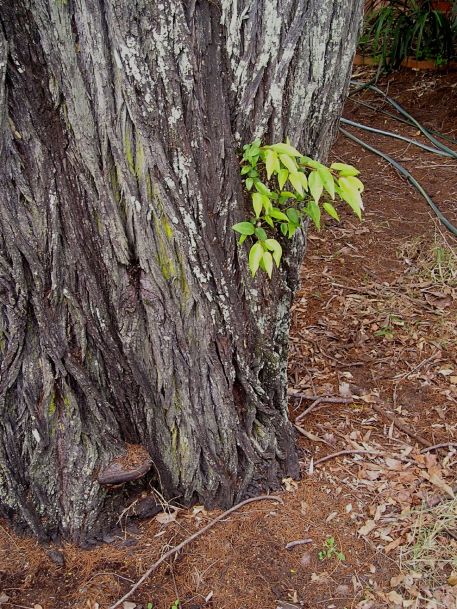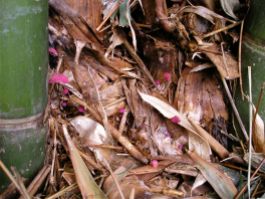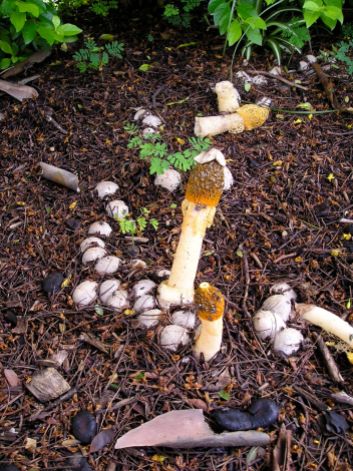Fungi. More closely related to animals than plants, and with 36,000 genders, the kingdom of fungi is full of surprises.
Largely ignored or misunderstood, their presence in a garden is essential for soil health. The few that we’re familiar with are generally pathogens, and some of those are indicators of poor horticulture.
The truth is, most fungi don’t even have a scientific name.
Coprophilous fungi specialise in digesting dung. These ‘dung fungi’ are a diverse group which employ grazing animals for transportation, and for improving their reproductive success. Koala and possum dung contains these fungi, and to continue their life cycle, these fungi are able to get their spores from the ground, where toadstools produce them, up and into the foliage eaten by these marsupials.
Dung also contains protozoa, mites, springtails and algae and many more microscopic life forms. Together with fungi, they collectively improve soil, helping dung to decompose and release its goodness.
Coprophilous fungi even provided the clues that helped establish that it was humans, not climate change, that caused the extinction of Australia’s megafauna.
If a seed is a whole plant, packed and ready to travel through time and space, then dung is it’s ecosystem equivalent.
Microscopic mycorrhizal fungi are the most exciting. These hold the key to plant health, plant nutrition and, thanks to the research at the Rodale Institute (USA), they are also the key to rapidly mitigating climate change.
Here’s a few favourite fungi, if you want to dig deeper, watch Paul Stamets ‘Six Ways Mushrooms Can Save the World’

Starfish fungus, Aseroe rubra, October 2008

Starfish fungus, Aseroe rubra

Starfish fungus, Aseroe rubra

Our neighbour’s Bribie Island pine under siege by bracket fungus, Ganoderma sp.

Coprinus disseminatus, digesting our sandwich mulch. 2005

Fungus Marasmius haematocephalus on bamboo debris. [ID by V. Ryan, qldfungi.org.au]

Fungus Marasmius haematocephalus [ID by V. Ryan, qldfungi.org.au]

The toadstool Humidicutis lewelliniae (syn. Hygrophorus lewellinae) usually prefers heathland bracken & undergrowth, but at my place it feeds on sugarcane…

Luminous bracket fungi at Vatthe Conservation area, Espiritu Santo, Vanuatu

Fusarium wilt attacking lavender roots. This ubiquitous genus is aggressive in warm, wet, humid conditions

A fabulous stinkhorn growing at Toowong Cemetery, Brisbane, during wet, summer conditions

Stinkhorn at Toowong cemetery. Cap still attached

Stinkhorn at Toowong cemetery

april toadstools

april toadstools

april toadstools

april toadstools

Toadstools emerging from our lawn. Autumn 2008

Black spot disease, Marssonina rosae, on rose at Sydney Botanic gardens. Prevent by spraying with sodium bicarbonate

Downy mildew on pumpkin at Beelarong Community garden, Brisbane. Prevent by spraying with milk solution

This delicate, but short-lived toadstool appears when autumn dewfall is heavy…

…and flourishes on sugarcane bales in late spring

tiny forests of these fungal fruiting bodies briefly appear after rain. 2005

Lantern stinkhorn, Lysurus mokusin, with blowfly pollinators

A mildew eating ladybird, lleis galbula, checking our choko for its favourite food

Mildew eating ladybird lleis galbula – forage on mildew-affected roses and Cucurbitaceae

Powdery mildew, Oidium sp., on old Moroccan mint foliage. This is the cue to prune mint to the ground.

Our first stinkhorn, Phallus flavocostatus

Stinkhorn, Phallus flavocostatus. Flies spread their sticky spores

Stinkhorn, Phallus flavocostatus – detail

Our own stinkhorn, Phallus flavocostatus – detail

Flies couldn’t resist this latest stinkhorn emerging from pine bark mulch. Late summer 2008

Stinkhorn with spore spreading blowflies. Late summer 2008 – detail

toadstool fungus on pinebark

Snow mould, Botrytis cinerea, on fescue turf at Sydney Botanic gardens. It’s most frequent in cool humid winters

A tough fungus first seen on pine bark in wet summer conditions

White felted patches of powdery mildew, Oidium sp., on rose at Sydney Botanic gardens. Prevent by spraying with

Powdery mildew, Oidium sp. Sydney Botanic gardens

Potting mix, mulch fungus, Leucocoprinus birnbaumii

Potting mix, mulch fungus, Leucocoprinus birnbaumii









































Hi, just letting you know that you’ve misidentified a couple of the fungi. What you have called Phallus flavocostatus is Phallus rubicundus. Your Lichenomphalia sp. looks like Marasmius haematocephalus. If you want to check, both species are in the Australian Subtropical Fungi book. Also, if you are interested in learning more about our wonderful local fungi and fungi in general, the Queensland Mycological Society has meetings every second Tuesday of the month, 7pm at the Queensland Herbarium. http://qldfungi.org.au/
Dear Vanessa,
Thanks for your email.
When it comes to fungi I am an amateur. I rely on experts, like yourself, to identify my images for my Bellis Checklist and I then publish them on my website and through Facebook.
I have altered the image caption as you suggest. I should really make a note on each image as to who has identified them. You are not the first to disagree with previous identifications made by other experts. With regard to fungi I have found experts regularly disagree with each other. I have consequently stopped entries on Bowerbird, fungus experts frequently disagree with each other or cannot identify fungi to the point that I no longer use that resource for help.
Thanks for alerting me to the Australian Subtropical Fungi book. If you would like to send me a copy for review I will do so and perhaps you might like me to interview you on my weekly gardening programme on 4BC Radio about this topic.
Let me know if you’re interested.
Kind regards
Jerry
I had a quite laugh at you comment above as I too have found that the experts seem to contradict each other at times! So to add to the cofustion over names fungus-2.jpg is likely Parasola plicatilis and img_1550.jpg is Coprinopsis lagopus